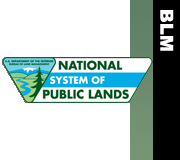|
Print Page | ||||||||||||
Cave & Karst Areas Program – The BLM manages nearly 800 caves, primarily in karst (limestone) regions. Caves are a fascinating and fragile world that is an important resource for scientific and historical research and environmental education. Caves also provide habitat for bats and other wild creatures. Some caves on BLM public lands are also available for public exploration. Heritage Resources – BLM lands contain many important archaeological and historic sites including ghost towns, ancient Puebloan villages, and rock art panels. These lands also have been home to many important fossil discoveries including dinosaur skeletons now on display in some of the Nation’s great museums. Interpretation Program – The BLM Interpretive Program serves visitors, promotes the health of the land, and enhances the public’s enjoyment, understanding and appreciation of the natural and cultural resources of the public lands. Also follow this link for a list of all BLM Interpretive Centers and related Field Offices. Recreation Fee/Permit Program – The BLM is committed to using recreation fees to improve on-the-ground recreation facilities and services. This link leads to information on BLM recreation fees and permits, the Federal Lands Recreation Enhancement Act (REA), the “America the Beautiful - National Parks and Federal Recreation Lands Pass”, and Recreation Resource Advisory Councils (Recreation RACs). River Recreation – Follow this link to BLM’s National River Database, information on BLM Wild and Scenic Rivers, and links to various river recreation and conservation partner organizations. Hunting/Shooting Sports – The BLM provides opportunities to hunt and engage in shooting sports activities in a safe and environmentally sound manner that promote marksmanship, public safety, hunter education, competition, and lawful hunting. The BLM partners with state governments, local communities, interest groups, shooting clubs and other organizations to develop safe and environmentally responsible hunting and shooting sports activities. Follow this link for answers to Frequently Asked Questions about target shooting. Stewardship & Outdoor Ethics Program – BLM promotes and supports land stewardship and outdoor education as a way to enhance the visitor experience; to further appreciation and understanding of BLM-managed land resources; and to minimize recreation impacts. Tourism & Community Services Program – BLM Recreation helps to sustain domestic tourism opportunities that provide valuable community amenities, attract new businesses, protect sensitive resources, and improve the quality of life for both visitors and residents. In turn, these efforts support sustainable economic growth, and assist with diversifying and stabilizing local communities. Trails System – BLM manages more than 16,000 miles of multiple-use trails, including approximately 6,000 miles of trails classified within the National Trails System. Travel Management Program – The BLM uses a comprehensive approach, including travel-related regulations, to proactively manage public access and natural resources according to best land use management principles. Visual Resource Management – BLM is responsible for managing the public lands for multiple uses, and for ensuring that the scenic values of these public lands are considered when providing for various uses. BLM’s Visual Resource Management (VRM) system involves inventorying scenic values and establishing management objectives for those values through the resource management planning process. Volunteers – The BLM partners with more than 20,000 Americans annually who volunteer nearly one-half million hours of their time and talent to accomplish land stewardship, enhancement, and other important projects to improve recreation opportunities on BLM-managed lands. |
|||||||||||||






